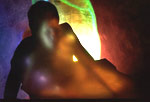February 20, 2005
dance with avatar

real time interactive performance event
Carol Brown Dances explores real and mediated bodily presence. Recent work The Changing Room is a real time interactive performance event intertwining the digital and the visceral in a sublime trio. In their changing room, three women leave behind the territory they know for another place, beyond what they know. A mirror becomes a screen for their mutations, a curtain a technological frontier and their table a platform for the puppetry of the virtual. Through a series of changing viewpoints the audience is lead to encounter the epic within the everyday, as a haunting virtual presence extends, mirrors and distorts the performer's behaviour. Animating the threshold between the virtual and the real, The Changing Room is an intimate exploration of our digital evolution. Designed for both live art and theatre spaces, The Changing Room encourages the shifting viewpoints of a mobile audience.
"The work which really stood out for me in Dance Umbrella for its boldness and imagination was "The Changing Room," from Carol Brown Dances, seen November 5 at Greenwich Dance Agency. Choreographer Carol Brown and architect Mette Ramsgard Thomsen transport the audience into another dimension, a world of virtual and real bodies in their challenging and creative work performed as an installation, around which the audience promenades, guided by Brown herself. Different performance areas are demarcated by one large screen and several smaller screens onto which a 'virtual body' or 'avatar' is projected. The virtual body, central to the work which is created by a technique called contour tracking, feeds off the dancers' movement. It is a mesmeric swirl of colour, circular in shape, that takes on different forms and resembles a pulsating sea anemone, a mutating cell and even a developing embryo.
"The performance by Brown and two dancers, Catherine Bennett and Delphine Gaborit, takes on the style of a lecture-demonstration in which the choreographer explains in poetic metaphorical language how they have worked as live bodies with something that is not tangible or organic. In her performance text she talks about the limitations of the organic body and how the virtual body could be something that does reach perfection, as it extends the possibilities of the physical body, "following our contours like distant geography." The most poignant and indeed emotive moments in the work are the points of connection between the dancers and the virtual body -- for example, when the dancers trace or touch the fluctuating presence on the screen or dance with it from a distance, retaining, still, a sensitivity, a constant awareness of this 'other.' Likewise, the virtual body, while visually powerful, never dominates the live action, but rather has a symbiotic relationship with it. Movements are adapted to activate the virtual presence; it can only feed off certain movements or dynamics and this poses limitations on what the body can do physically as well as offering other potential.
"A theatrical quality is established by the frequent costume changes of the three dancers, Michael Mannion's lighting and Jerome Soudan's score. Shanti Freed's costumes feature white fitted tunics which can be stretched into all kinds of shapes, thus extending the body like a second skin; baroque fashion accessories such as a white fur coat, a red satin glove and red stiletto shoes; and white underwear stripped down to reveal the muscle and flesh of these live bodies. Soudan's rich musical text, combining electronic sound and collages of classical music and monks' chanting, further wraps the work in more layers of meaning. The dancers look at times like high priestesses in a Sci-Fi film, or sometimes like Replicants but never like ordinary dancers. The lighting design, white space and screens, the text, choreography, sound, costumes and appearances of the virtual body transform the space into a cocoon-like research laboratory, an interface where different worlds meet, where each element/component co-habits or even merges. However you interpret it, "The Changing Room" is about a 'meeting,' and the three women performers are like pioneers on the verge of discovering a brave new world. The last image that we are left with is the virtual body diminishing slowly and softly, the child of these women inventors.
"The Changing Room" was the result of nearly two years of experiment and research. Thomsen, an architect working in new media and virtual environments, worked closely with Brown on how to mix realities -- that of the virtual and the live -- and developed a way of working with experimental choreographic systems which was based on Brown's interest in merging new media with dance-theater. Another enlightening aspect of "The Changing Room" is that it deals with women's bodies, and suggests birth and creation, which is refreshing in the field of new technologies, so often dominated by men sitting behind computers. "
From Flash Review
Posted by michelle at February 20, 2005 11:35 PM
